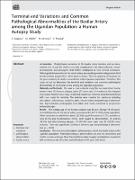| dc.description.abstract | Morphological variations at the basilar artery terminal end are documented
risk factors for cerebral vascular complications like atherosclerosis, thromboembolisms,
and aneurysms that further predispose to fatal arterial occlusions.
Pathological abnormalities of the basilar artery are usually ignored on diagnosis in third
world countries despite their role in brain ischemia. There is a paucity of literature on
the gross anatomy of cerebral vasculature in the Ugandan population. Therefore, this
study set out to determine the terminal end variations and common pathological
abnormalities of the basilar artery among the Ugandan population.
Materials and Methods This was a cross sectional study that accessed intact basilar
arteries from 115 human autopsy brains (77 males and 33 females) at the Kampala
City Council Authoritymortuary. Arachnoidmatter was removed and arteries perfused
with clear water for visibility. The arteries were checked for variations including
bifurcations, trifurcations, quadrifurcation, hexafuraction and pathological abnormalities.
Representative photographs were taken and results presented as proportions
and percentages.
Results The average age of the human cadavers was 38 years (Range 18–85 years).
Normal bifurcation of the basilar artery was observed in 48.7% of the study population.
Other variations included trifurcations (22.6%); quadrifurcations (21.7%), pentafurcations
(6.1%) and hexafurcations (0.6%). With regard to abnormalities, 16 arteries
(13.9%) had atheromatous plaques, 21 (18.3%) were rigid, and 26 (22.6%) were
tortuous. There was significant correlation between age and pathological abnormalities
(p ¼ 0.01)
Conclusion There are several variations at the terminal end of the basilar artery in the
Ugandan population. Arterial pathological abnormalities are also not uncommon and
tend to increase with age. Thus, the need for routine imaging investigations in patients with cerebrovascular disorders and individuals of 40 years and above. | en_US |

